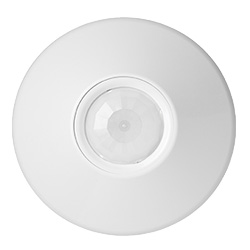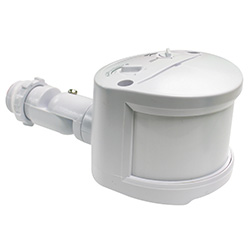Occupancy Sensor Application Guide
This product guide offers a list of different occupancy sensors associated with their intended application such as sensor location, room type, and area space.
Locations for Occupancy Sensors:
Occupancy Sensors for Small Offices
Automatic Wall Switch Occupancy Sensor
Automatic wall sensors are for small and individual offices. Sensors should have a direct, clear front view of stationary occupants. Do not place the sensor where
it can be blocked by doors, filing cabinets, furniture, or other solid objects.
Shop Wall Switch Sensors
Ultrasonic Occupancy Sensor
For offices with large obstacles or stationary workers. This occupancy sensor covers up to 750 ft2, detects motion around obstacles, and is more
sensitive to small movements than PIR (Passive Infrared) sensors. It should be placed close to the area of activity and out of view of doors so waves do not
exit the room.
Shop Ultrasonic Sensors
360° Ceiling Mount or Wide Angle Occupancy Sensor
360° Ceiling Mount or Wide Angle Occupancy Sensors are for small, individual offices where wall switch location is a problem. Wide angle sensors
are best for offices with general activity and can be placed in a corner. 360° Ceiling Mount sensors are better for offices with multiple obstacles
because. When mounted on the ceiling, it provides 360° coverage from the center of the room.
Shop 360° Ceiling Sensors
Occupancy Sensors for Conference Rooms and Training Rooms
360° Ceiling Mount Occupancy Sensor
Ceiling mount sensors are for small conference rooms where a ceiling mount sensor is required. 360° ceiling mount occupancy sensors should be
located where they will have a clear view of the entire room, but cannot see out the door.
Shop 360° Ceiling Sensors
Automatic Wall Switch Occupancy Sensor
Wall switch sensors are for small conference rooms under 300 ft2. Automatic wall switch occupancy sensors should be within 20 ft of the farthest wall
to ensure detection at the far end of a room.
Shop Wall Switch Sensors
Ultrasonic Occupancy Sensor
Ultrasonic occupancy sensors are for small conference rooms without moving equipment that could falsely activate the sensor. This ultrasonic occupancy sensor
works well in a room up to 750 ft2 Multiple sensors may be used in larger rooms.
Shop Ultrasonic Sensors
Wide Angle Occupancy Sensor
Wide angle occupancy sensors are for medium-sized conference rooms (400 - 1000 ft2) without obstacles that may block a PIR sensor's view.
Shop Wide Angle Sensors
360° Ceiling Mount or Wide Angle Occupancy Sensor
For conference rooms that are 1000 - 2500 ft2, two wide angle occupancy sensors will work well when installed in opposite corners. One of the sensors should be
placed to immediately sense occupants entering the room. Rooms greater than 2500 ft2 should use multiple sensors.
Shop 360° Ceiling Sensors
Occupancy Sensors for Lunch/Break Rooms, Copy Rooms, and Utility Rooms
Automatic Wall Switch Occupancy Sensor
An automatic wall switch sensor will work well in rooms smaller than 300 ft2 when it has a direct, clear view of occupants.
Shop Wall Switch Sensors
Ultrasonic Occupancy Sensor
An ultrasonic occupancy sensor is a better choice for rooms smaller than 300 ft2 if occupants spend a lengthy period of time behind
cabinets or other structures.
Shop Ultrasonic Sensors
Occupancy Sensors for Restroom
Ultrasonic Occupancy Sensor
Due to the many partitions in commercial restrooms, an ultrasonic ceiling mount sensor is needed. Multiple sensors may be used in larger restrooms.
Shop Ultrasonic Sensors
Occupancy Sensor for Hallways
PIR Wall Mount Occupancy Sensor
In hallways without obstructions or where coverage masking is required, a PIR wall mount sensor is perfect. When mounted between
10 ft and 14 ft high, passive infrared sensors can have a coverage area of up to 10 ft x 90 ft. Sensors should focus on areas where people will be entering the space.
Shop PIR Sensors
Occupancy Sensor vs Motion Sensor: Is There a Difference?
Occupancy Sensor

Occupancy sensors are specialized sensors designed to detect the presence or absence of people within a designated area using advanced technologies
such as passive infrared (PIR), ultrasonic, or dual-technology sensing. Occupancy sensors optimize energy usage and enhance convenience by automatically
adjusting environmental settings based on human occupancy like lighting, HVAC systems, and other devices.
Motion Sensor

Unlike occupancy sensors, motion sensors do not specifically focus on human presence, but instead detect the motion of objects, people, or animals. Motion detectors
are commonly installed in both indoor and outdoor settings,
including homes, businesses, and public spaces, to increase safety and security. Motion sensors utilize various technologies such as passive infrared (PIR),
microwave, ultrasonic, or camera-based sensors to detect motion efficiently.
Shop Related Sensor Products
Warning: When using this information to perform electrical work, call a licensed electrician and consult the NEC® for safety.
All licensed electricians have passed examinations covering the National Electric Code®, know state and local building codes,
and may carry insurance to cover damages